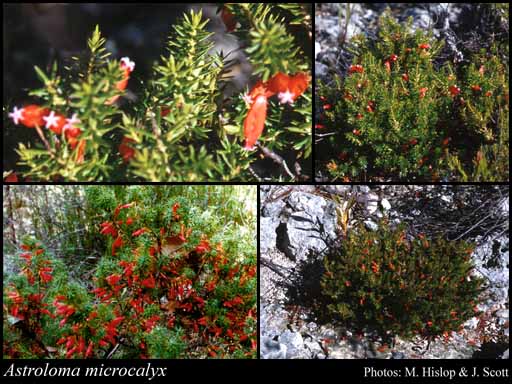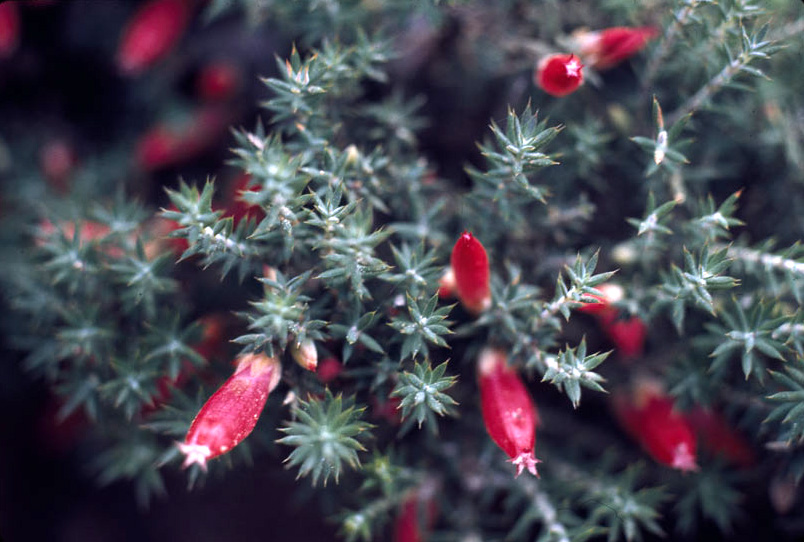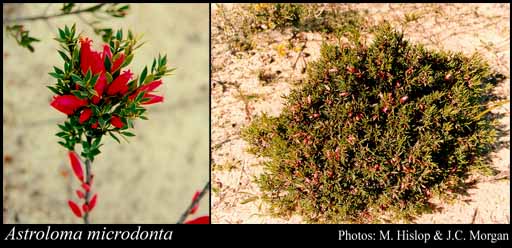Red Flowered Styphelia Species of Jurien Bay and Surrounds
Updated 26/2/2024. Index to my other posts.
The purpose of this post is to gather the available information about the red flowering Styphelia species in Jurien Bay and surrounds to facilitate their identification. Comments on this post are very welcome!
[At this stage this is a draft for comment. I will include some notes in square brackets which will hopefully be deleted as the post develops.]
Seven species of large leaved red flowering Styphelia in the area were identified by @thebeachcomber as follows:
| Species | Previous name | Common name |
|---|---|---|
| Styphelia discolor | Astroloma ciliatum | Moss-leaved Heath or Candle Cranberry |
| Styphelia erubescens | Leucopogon oxycedrus | |
| Styphelia microcalx | Astroloma microcalyx | |
| Styphelia microdonta | Astroloma microdonta | Sandplain Cranberry |
| Styphelia serratifolia | Astroloma serratifolium | |
| Styphelia stomarrhena | Astroloma stomarrhena | Red Swamp Cranberry |
| Styphelia tortifolia | Astroloma glaucescens |
Of these species all are shown by Florabase to have been collected in the area except S. erubescens which is included in the Hi Vallee Field Guide. Hi Vallee farm is in the Jurien Bay and surrounds.
Styphelia discolor
There is a description for this species in Flora of the South West: Bunbury-Augusta-Denmark, in summary:
Shrub, ground hugging or up to 0.3m. Leaves narrowly oblong 5–11mm long and 0.5–1.5mm wide, hairless or sparsley hairy, flat to slightly convex, margin fringed with stiff hairs, tip a harsh point 0.5–1mm long. Flowers purple to dark red, corolla tube very long (20–30mm), lobes bearded and often paler than the tube.

Photo (c) robert davis, some rights reserved (CC BY-NC) Observation
The flowers are very distinctive and I don’t think this species would cause confusion whilst in flower.
Styphelia erubescens
There is a description for this species in Flora of the South West: Bunbury-Augusta-Denmark, in summary:
Shrub to 1m. Leaves erect to spreading, narrowly elliptic to elliptic, 5–14mm long 2.5–3.5mm wide, flat, long-pointed and spine tipped. Flowers white in small drooping clusters of only 1 or 2 flowers, sepals ovate, rounded, 2–3.5mm long, much shorter than the corolla tube, corolla 7–14mm long, style exerted.
Adding to this, in the Jurien Bay area the flowers are red (Hi Vallee Field Guide) and the leaf margins are smooth and hairless (from looking at photos in Hi Vallee Field Guide and elsewhere).

(c) Shankar Meyer, some rights reserved (CC BY-NC) Observation
Styphelia microcalyx
Florabase profile of Astroloma microcalyx: Erect or straggling shrub, 0.2–0.6 m high. Fl. red/white, Jun to Sep. White or brown sand or loam, limestone, laterite. Coastal areas.
How To Know Western Australian Wild Flowers (Blackall & Grieve): Flowers large (about 15mm long), red, sepals minutely spiny tipped, 4–5mm long, bracteoles less than 2mm long. Leaves 20mm long usually glabrous but if margins are revolute they are ciliate.
Flora of the Perth Region has the following description:
Erect or diffuse shrub to .6m high, with branchlets minutely hairy. Leaves linear to narrowly oblong, 4–8 x 0.5–1 mm, glabrous, convex, mucronate with a mucro ca 1mm long, margins minutely denticulate, recurved to revolute; the upper leaves erect and the lower leaves spreading. Bracteoles broadly elliptic to circular, 1–2 mm long, minutely hairy, mucronate. Sepals elliptic, ca 5 mm long, glabrous or sparsely hairy towards the apex, mucronulate.
Corolla red or white, 10–13 mm long; tube nearly twice as long as the sepals. hairy at the throat, with 5 tufts of hairs inside near the base; lobes acuminate, bearded. Staminal filaments flattened. Mature drupes not seen.
Occurs usually on near-coastal limestone of the coastal plain from Yanchep to Fremantle. Also recorded from Lake Indoon.
Flowers June - August
This species is similar to A glaucescens, but the latter has longer, flat leaves with a shorter mucro and longer bracteoles and sepals.

Florabase profile picture for Astroloma microcalyx

(c) Australian National Botanic Gardens (ANBG), photographer J. Wrigley
Styphelia microdonta
[There is a description and drawings of this species in Blackall and Grieves however it is somewhat at odds with other descriptions, included here for discussion.]
Blackall and Grieves: Erect shrub 30–90cm high. Leaves 5–15mm long about 3mm wide denticulate, flat tapering to a pungent point. Flowers red nearly sessile 10mm long, sepals about half as long as corolla, corolla somewhat bulbous. Flowering Apr-Sept.
Hi Vallee Field Guide: Flowering Apr-Jun or Aug-Oct. Flowers red or pink, corolla tube wider at base than top. Leaf margins stiffly hairy. Low spreading shrub to 35cm tall.
Florabase profile description for Astroloma microdonta: Low spreading shrub, 0.1–0.35 m high. Fl. red/pink, Apr to Jun or Aug to Oct. White/grey or yellow sand over laterite. Sandplains.
Whilst “Flora of the Perth Region” does not have an entry for Styphelia microdonta there is the following footnote under the Styphelia pallida listing: “This Species is very similar to the more northern S microdonta which differs in having a shorter pink to red Corolla, more obtuse, deeply coloured sepals and more prominantly denticulate leaves”. Styphelia pallida is described as having narrowly ovate, elliptic or obovate leaves 7–18mm x 2–3.5mm, flat or concave, tapering gradually to a long pungent mucro ca 1.5mm long, margins denticulate to ciliate. A prostrate shrub to 0.3m.
[Thanks Russell for this]
Flora of the South West describes the leaves of Styphelia pallida as having margins fringed with sparse rigid hairs. Click through to Russell’s observation (linked beneath his photo below) and that is what you will see on the leaves.
This syntype of Styphelia microdonta found on ALA has exactly the same sort of hairs on the leaf margins.
[This syntype is a bit of a clincher, compare the leaves with Russ’ observation]

Florabase profile picture for Astroloma microdonta

(c) Russ Chambers, some rights reserved (CC BY-NC) Observation
Styphelia serratifolia
The description and drawings in Blackall & Grieves for this species are helpful. Shrub up to 1m high, a polymorphic species. Leaves ovate to broadly lanceolate, concave, prominently denticuate-serrated, may be recurved, spreading or erect. Flowers red, solitary in axils about 10mm long sepals about half the length of the corolla.
Blackall & Grieve has two varieties with quite different leaf shape and orientation but this differentiation no longer appears to apply. The important common feature of the leaves is, in any case, the serrated margins.

(c) geoffbyrne, some rights reserved (CC BY-NC) Observation
Styphelia stomarrhena
Hi Vallee Field Guide: Flowering Mar-Jul, flowers red corolla lobes spreading at the top, stamens protruding in a dense white wooly mass, hairy shrub to 0.6m tall.
Blackall and Grieves: Flowering May-Sept, flowers red, sepals hairy, anthers in a wooly mass, leaves sessile, lanceolate, concave, striate, tapering to a pungent point the drawings show quite long hairs.
In flower this species is quite distinctive.

(c) robert davis, some rights reserved (CC BY-NC) Observation
Styphelia tortifolia
Hi Vallee Field Guide: Flowering period Mar or May to Oct. Flowers red corolla tube swollen, leaves grey green. Plant is glabrous (not hairy) or slightly pubescent. Pungent shrub to 0.6m tall.
Florabase profile of Astroloma glaucescens: Erect, compact, pungent shrub, 0.1–0.6 m high. Fl. red, Mar or May to Oct. Sandy & lateritic gravelly soils.
Name - Australian Systematic Botany, 2020, 33, 137–168: From the Latin tortus (twisted) and folium (leaf), a reference to the longitudinally twisted leaves that are a common feature of this species.

(c) Tim Hammer, some rights reserved (CC BY-NC) Observation




Comentarios
Looks great so far, well done.
I have nothing to add at the moment as I'm far from home and my field guides and computer!!
Nice work Keith. I got erubescens from its inclusion in the Hi Vallee guide (the property is at Badgingarra)
Great job here, Styphelia always takes more time than it should to ID. One thing - I notice styphelia serratifolium should be serratifolia, latter is current I believe.
Agregar un comentario